Scientific Knowledge Mapping and Thematic Evolution for Tire Wear Particles
Abstract
:1. Introduction
2. Data and Methods
2.1. Data Source
2.2. Data Analysis
3. Results and Discussions
3.1. Time and Space Publishing Trends
3.2. Preferred Journals and Subject Areas
3.3. Research Topics and Evolution
4. Conclusions and Outlook
- The presence of TWPs in environmental media is high, mainly due to the friction between the tire and road surface causing the release of TWPs from the tire to the environment [52]. Tire manufacturing is a balance between fuel economy, safety, durability, and environmental protection, and wear resistance bias will cause fuel economy and safety shortfalls [53]. Developing a new tire formula is thus a future direction for research. Road conditions can affect the release of TWPs. A relatively smooth road surface can reduce tire wear, and pores of relatively large patterns on the road surface can effectively intercept large TWPs [54]. Therefore, reducing emissions at the source by using wear-resistant tires, autonomous vehicles (with artificial intelligence to reduce wear), green vehicles and improved road materials is important.
- As TWPs contain a large amount of heavy metals and organic pollutants, as with other plastics they have a high environmental persistence. TWPs can also form new toxicants under physical and chemical reactions such as heating/friction [55]. Reducing the amount of harmful additives in TWPs can alleviate leaching contamination of TWPs, such as reducing the amount of high aromatic oils to reduce the leaching of PAHs [22]. However, many of the processes and effects discussed can also be used as reference for particle pollution of other polymer composites, and related research is urgently needed.
- TWPs can act as a pollutant carrier, which can adsorb and enrich a large amount of inorganic/organic pollutants in the environment and cause severe damage to the surrounding environment as a continuous migration and dispersal carrier. TWPs could be migrated from the pavement through surface runoff, pavement sweeping, and resuspension into the air. Among them, surface runoff is the most important migration method, followed by road cleaning, and therefore controlling these two transfer processes can effectively reduce the number of tire wear particles diffused into the environmental medium [56]. It is worth noting that the pavement sweeping process can transfer TWPs from the pavement to other places, but the collected pavement particles and pollutants may cause secondary pollution by random disposal.
- Given that the aging process affects the environmental behavior and toxicity of TWPs in soil [57], future work should focus on morphological and structural changes in TWPs during weathering and aging and additive release and on TWP toxicity tests with natural weathering or aging. Also of concern is that some of the TWPs enter the drainage system with runoff, and after treatment in the wastewater treatment plant, their surface structure is oxidized by hypochlorous acid; advanced oxidation may accelerate the aging process of TWPs [58].
- New methods for detecting TWPs are constantly being developed, but each method has its advantages and disadvantages. Accurate quantification of TWPs in the environment is still a great challenge. Establishing a unified tire wear particle detection standard and perfect preprocessing overlay with precise instrumentation is the future trend of development of tire wear particle detection technology, while combining multiple detection methods would get better results. New methods are urgently needed, and existing methods need to be improved.
Author Contributions
Funding
Institutional Review Board Statement
Informed Consent Statement
Data Availability Statement
Acknowledgments
Conflicts of Interest
References
- Thompson, R.C.; Olsen, Y.; Mitchell, R.P.; Davis, A.; Rowland, S.J.; John, A.W.; McGonigle, D.; Russell, A.E. Lost at sea: Where is all the plastic? Science 2004, 304, 838. [Google Scholar] [CrossRef]
- Li, J.; Lusher, A.L.; Rotchell, J.M.; Deudero, S.; Turra, A.; Bråte, I.L.N.; Sun, C.; Hossain, M.S.; Li, Q.; Kolandhasamy, P.; et al. Using mussel as a global bioindicator of coastal microplastic pollution. Environ. Pollut. 2019, 244, 522–533. [Google Scholar] [CrossRef]
- Dikareva, N.; Simon, K.S. Microplastic pollution in streams spanning an urbanisation gradient. Environ. Pollut. 2019, 250, 292–299. [Google Scholar] [CrossRef]
- Kumar, M.; Xiong, X.; He, M.; Tsang, D.C.; Gupta, J.; Khan, E.; Harrad, S.; Hou, D.; Ok, Y.S.; Bolan, N.S. Microplastics as pollutants in agricultural soils. Environ. Pollut. 2020, 265 Pt A, 114980. [Google Scholar] [CrossRef]
- Ma, H.; Pu, S.; Liu, S.; Bai, Y.; Mandal, S.; Xing, B. Microplastics in aquatic environments: Toxicity to trigger ecological consequences. Environ. Pollut. 2020, 261, 114089. [Google Scholar] [CrossRef]
- Hartmann, N.B.; Huffer, T.; Thompson, R.C.; Hassellov, M.; Verschoor, A.; Daugaard, A.E.; Rist, S.; Karlsson, T.; Brennholt, N.; Cole, M.; et al. Are We Speaking the Same Language? Recommendations for a Definition and Categorization Framework for Plastic Debris. Environ. Sci. Technol. 2019, 5, 1039–1047. [Google Scholar] [CrossRef] [Green Version]
- Fytianos, G.; Ioannidou, E.; Thysiadou, A.; Mitropoulos, A.C.; Kyzas, G.Z. Microplastics in Mediterranean coastal countries: A recent overview. J. Mar. Sci. Eng. 2021, 9, 98. [Google Scholar] [CrossRef]
- Thompson, R.N.; Nau, C.A.; Lawrence, C.H. Identification of vehicle tire rubber in roadway dust. Am. Ind. Hyg. Assoc. J. 1966, 27, 488–495. [Google Scholar] [CrossRef]
- Goßmann, I.; Halbach, M.; Scholz-Böttcher, B.M. Car and truck tire wear particles in complex environmental samples–a quantitative comparison with “traditional” microplastic polymer mass loads. Sci. Total Environ. 2021, 773, 145667. [Google Scholar] [CrossRef]
- Dong, X.; Zhu, L.; Jiang, P.; Wang, X.; Liu, K.; Li, C.; Li, D. Seasonal biofilm formation on floating microplastics in coastal waters of intensified marinculture area. Mar. Pollut. Bull. 2021, 171, 112914. [Google Scholar] [CrossRef]
- Galafassi, S.; Nizzetto, L.; Volta, P. Plastic sources: A survey across scientific and grey literature for their inventory and relative contribution to microplastics pollution in natural environments, with an emphasis on surface water. Sci. Total Environ. 2019, 693, 133499. [Google Scholar] [CrossRef] [PubMed]
- Kole, P.J.; Löhr, A.J.; Van Belleghem, F.G.A.J.; Ragas, A.M. Wear and tear of tyres: A stealthy source of microplastics in the environment. Int. J. Environ. Res. Public Health 2017, 14, 1265. [Google Scholar] [CrossRef] [PubMed]
- Leads, R.R.; Weinstein, J.E. Occurrence of tire wear particles and other microplastics within the tributaries of the Charleston Harbor Estuary, South Carolina, USA. Mar. Pollut. Bull. 2019, 145, 569–582. [Google Scholar] [CrossRef]
- Verschoor, A.J. Towards a Definition of Microplastics: Considerations for the Specification of Physico-Chemical Properties; National Institute for Public Health and the Environment: Bilthoven, The Netherlands, 2015.
- Sieber, R.; Kawecki, D.; Nowack, B. Dynamic probabilistic material flow analysis of rubber release from tires into the environment. Environ. Pollut. 2020, 258, 113573. [Google Scholar] [CrossRef] [PubMed]
- Sheng, Y.; Liu, Y.; Wang, K.; Cizdziel, J.V.; Wu, Y.; Zhou, Y. Ecotoxicological effects of micronized car tire wear particles and their heavy metals on the earthworm (Eisenia fetida) in soil. Sci. Total Environ. 2021, 793, 148613. [Google Scholar] [CrossRef] [PubMed]
- Horton, A.A.; Walton, A.; Spurgeon, D.J.; Lahive, E.; Svendsen, C. Microplastics in freshwater and terrestrial environments: Evaluating the current understanding to identify the knowledge gaps and future research priorities. Sci. Total Environ. 2017, 586, 127–141. [Google Scholar] [CrossRef] [PubMed] [Green Version]
- Wagner, S.; Hüffer, T.; Klöckner, P.; Wehrhahn, M.; Reemtsma, T. Tire wear particles in the aquatic environment-a review on generation, analysis, occurrence, fate and effects. Water Res. 2018, 139, 83–100. [Google Scholar] [CrossRef]
- Fan, X.; Ma, Z.; Zou, Y.; Liu, J.; Hou, J. Investigation on the adsorption and desorption behaviors of heavy metals by tire wear particles with or without UV ageing processes. Environ. Res. 2021, 195, 110858. [Google Scholar] [CrossRef]
- Brennecke, D.; Duarte, B.; Paiva, F.; Caçador, I.; Canning-Clode, J. Microplastics as vector for heavy metal contamination from the marine environment. Estuar. Coast. Shelf Sci. 2016, 178, 189–195. [Google Scholar] [CrossRef]
- Gewert, B.; Plassmann, M.M.; MacLeod, M. Pathways for degradation of plastic polymers floating in the marine environment. Environ. Sci. Process. Impacts 2015, 17, 1513–1521. [Google Scholar] [CrossRef]
- Baensch-Baltruschat, B.; Kocher, B.; Stock, F.; Reifferscheid, G. Tyre and road wear particles (TRWP)-A review of generation, properties, emissions, human health risk, ecotoxicity, and fate in the environment. Sci. Total Environ. 2020, 733, 137823. [Google Scholar] [CrossRef] [PubMed]
- Luo, Z.; Zhou, X.; Su, Y.; Wang, H.; Yu, R.; Zhou, S.; Xu, E.G.; Xing, B. Environmental occurrence, fate, impact, and potential solution of tire microplastics: Similarities and differences with tire wear particles. Sci. Total Environ. 2021, 795, 148902. [Google Scholar] [CrossRef]
- Wik, A.; Dave, G. Occurrence and effects of tire wear particles in the environment–A critical review and an initial risk assessment. Environ. Pollut. 2009, 157, 1–11. [Google Scholar] [CrossRef] [PubMed]
- Adamiec, E.; Jarosz-Krzemińska, E.; Wieszała, R. Heavy metals from non-exhaust vehicle emissions in urban and motorway road dusts. Environ. Monit. Assess. 2016, 188, 369. [Google Scholar] [CrossRef] [Green Version]
- Wei, T.J.; Guan, D.-X.; Li, X.-Y.; Hao, Y.-L.; Teng, H.H.; Yang, J.-F.; Xu, Y.-Y.; Li, G. Analysis of studies on environmental measurements using diffusive gradients in thin-films (DGT) from 1994 to 2020. J. Soils Sediments 2022, 22, 1069–1079. [Google Scholar] [CrossRef]
- Cadle, S.H.; Williams, R.L. Environmental degradation of tire-wear particles. Rubber Chem. Technol. 1980, 53, 903–914. [Google Scholar] [CrossRef]
- Unice, K.M.; Weeber, M.; Abramson, M.; Reid, R.; van Gils, J.; Markus, A.; Vethaak, A.; Panko, J. Characterizing export of land-based microplastics to the estuary—Part I: Application of integrated geospatial microplastic transport models to assess tire and road wear particles in the Seine watershed. Sci. Total Environ. 2019, 646, 1639–1649. [Google Scholar] [CrossRef]
- Lough, G.C.; Schauer, J.J.; Park, J.S.; Shafer, M.M.; DeMinter, J.T.; Weinstein, J.P. Emissions of metals associated with motor vehicle roadways. Environ. Sci. Technol. 2005, 39, 826–836. [Google Scholar] [CrossRef]
- Councell, T.B.; Duckenfield, K.U.; Landa, E.R.; Callender, E. Tire-wear particles as a source of zinc to the environment. Environ. Sci. Technol. 2004, 38, 4206–4214. [Google Scholar] [CrossRef]
- Adachi, K.; Tainosho, Y. Characterization of heavy metal particles embedded in tire dust. Environ. Int. 2004, 30, 1009–1017. [Google Scholar] [CrossRef]
- Dong, J.; Huang, H.; Pei, J.; Xu, Y.; Cao, J. A methodology for capturing tire wear particles: Computational particle fluid dynamics modelling and experimental verification. Powder Technol. 2021, 384, 176–185. [Google Scholar] [CrossRef]
- Grigoratos, T.; Gustafsson, M.; Eriksson, O.; Martini, G. Experimental investigation of tread wear and particle emission from tyres with different treadwear marking. Atmos. Environ. 2018, 182, 200–212. [Google Scholar] [CrossRef]
- Varshney, S.; Gora, A.H.; Siriyappagouder, P.; Kiron, V.; Olsvik, P.A. Toxicological effects of 6PPD and 6PPD quinone in zebrafish larvae. J. Hazard. Mater. 2022, 424, 127623. [Google Scholar] [CrossRef] [PubMed]
- Dall’Osto, M.; Beddows, D.C.S.; Gietl, J.K.; Olatunbosun, O.A.; Yang, X.; Harrison, R.M. Characteristics of tyre dust in polluted air: Studies by single particle mass spectrometry (ATOFMS). Atmos. Environ. 2014, 94, 224–230. [Google Scholar] [CrossRef] [Green Version]
- Panko, J.M.; Hitchcock, K.M.; Fuller, G.W.; Green, D. Evaluation of tire wear contribution to PM2. 5 in urban environments. Atmosphere 2019, 10, 99. [Google Scholar] [CrossRef] [Green Version]
- Lin, Y.C.; Tsai, C.J.; Wu, Y.C.; Zhang, R.; Chi, K.-H.; Huang, Y.-T.; Lin, S.-H.; Hsu, S.-C. Characteristics of trace metals in traffic-derived particles in Hsuehshan Tunnel, Taiwan: Size distribution, potential source, and fingerprinting metal ratio. Atmos. Chem. Phys. 2015, 15, 4117–4130. [Google Scholar] [CrossRef] [Green Version]
- Gillibert, R.; Magazzù, A.; Callegari, A.; Bronte-Ciriza, D.; Foti, A.; Donato, M.G.; Maragò, O.M.; Volpe, G.; de La Chapelle, M.L.; Lagarde, F.; et al. Raman tweezers for tire and road wear micro-and nanoparticles analysis. Environ. Sci. Nano 2022, 9, 145–161. [Google Scholar] [CrossRef]
- Felsing, S.; Kochleus, C.; Buchinger, S.; Brennholt, N.; Stock, F.; Reifferscheid, G. A new approach in separating microplastics from environmental samples based on their electrostatic behavior. Environ. Pollut. 2018, 234, 20–28. [Google Scholar] [CrossRef]
- Chang, X.; Huang, H.-B.; Jiao, R.-N.; Liu, J.-P. Experimental investigation on the characteristics of tire wear particles under different non-vehicle operating parameters. Tribol. Int. 2020, 150, 106354. [Google Scholar] [CrossRef]
- Tonegawa, Y.; Sasaki, S. Development of tire-wear particle emission measurements for passenger vehicles. Emiss. Control Sci. Technol. 2021, 7, 56–62. [Google Scholar] [CrossRef]
- Dalmau, M.E.; Augsburg, K.; Wenzel, F.; Ivanov, V. Tire particle emissions: Demand on reliable characterization. Tire Sci. Technol. 2020, 48, 107–122. [Google Scholar] [CrossRef]
- Lenaker, P.L.; Baldwin, A.K.; Corsi, S.R.; Mason, S.A.; Reneau, P.C.; Scott, J.W. Vertical distribution of microplastics in the water column and surficial sediment from the Milwaukee River Basin to Lake Michigan. Environ. Sci. Technol. 2019, 53, 12227–12237. [Google Scholar] [CrossRef] [PubMed] [Green Version]
- Rødland, E.S.; Lind, O.C.; Reid, M.J.; Heier, L.S.; Okoffo, E.D.; Rauert, C.; Thomas, K.V.; Meland, S. Occurrence of tire and road wear particles in urban and peri-urban snowbanks, and their potential environmental implications. Sci. Total Environ. 2022, 824, 153785. [Google Scholar] [CrossRef] [PubMed]
- Yan, H.; Zhang, L.; Liu, L.; Wen, S. Investigation of the external conditions and material compositions affecting the formation mechanism and size distribution of tire wear particles. Atmos. Environ. 2021, 244, 118018. [Google Scholar] [CrossRef]
- Amato, F.; Cassee, F.R.; van der Gon, H.A.D.; Gehrig, R.; Gustafsson, M.; Hafner, W.; Harrison, R.M.; Jozwicka, M.; Kelly, F.J.; Moreno, T.; et al. Urban air quality: The challenge of traffic non-exhaust emissions. J. Hazard. Mater. 2014, 275, 31–36. [Google Scholar] [CrossRef]
- Pant, P.; Harrison, R.M. Estimation of the contribution of road traffic emissions to particulate matter concentrations from field measurements: A review. Atmos. Environ. 2013, 77, 78–97. [Google Scholar] [CrossRef]
- Harrison, R.M.; Giorio, C.; Beddows, D.C.; Dall’Osto, M. Size distribution of airborne particles controls outcome of epidemiological studies. Sci. Total Environ. 2010, 409, 289–293. [Google Scholar] [CrossRef]
- Purba, L.D.A.; Khudzari, J.M.; Iwamoto, K.; Mohamad, S.E.; Yuzir, A.; Abdullah, N.; Shimizu, K.; Hermana, J. Discovering future research trends of aerobic granular sludge using bibliometric approach. J. Environ. Manag. 2022, 303, 114150. [Google Scholar] [CrossRef]
- Rødland, E.S.; Samanipour, S.; Rauert, C.; Okoffo, E.D.; Reid, M.J.; Heier, L.S.; Lind, O.C.; Thomas, K.V.; Meland, S. A novel method for the quantification of tire and polymer-modified bitumen particles in environmental samples by pyrolysis gas chromatography mass spectroscopy. J. Hazard. Mater. 2022, 423, 127092. [Google Scholar] [CrossRef]
- Chae, E.; Jung, U.; Choi, S.S. Quantification of tire tread wear particles in microparticles produced on the road using oleamide as a novel marker. Environ. Pollut. 2021, 288, 117811. [Google Scholar] [CrossRef]
- Agathokleous, E.; Iavicoli, I.; Barceló, D.; Calabrese, E.J. Ecological risks in a ‘plastic’ world: A threat to biological diversity? J. Hazard. Mater. 2021, 417, 126035. [Google Scholar] [CrossRef] [PubMed]
- Kreider, M.L.; Panko, J.M.; McAtee, B.L.; Sweet, L.I.; Finley, B.L. Physical and chemical characterization of tire-related particles: Comparison of particles generated using different methodologies. Sci. Total Environ. 2010, 408, 652–659. [Google Scholar] [CrossRef] [PubMed]
- Klöckner, P.; Reemtsma, T.; Eisentraut, P.; Braun, U.; Ruhl, A.S.; Wagner, S. Tire and road wear particles in road environment–Quantification and assessment of particle dynamics by Zn determination after density separation. Chemosphere 2019, 222, 714–721. [Google Scholar] [CrossRef]
- Hüffer, T.; Wagner, S.; Reemtsma, T.; Hofmann, T. Sorption of organic substances to tire wear materials: Similarities and differences with other types of microplastic. Trends Analyt. Chem. 2019, 113, 392–401. [Google Scholar] [CrossRef]
- Polukarova, M.; Markiewicz, A.; Björklund, K.; Strömvall, A.M.; Galfi, H.; Sköld, Y.A.; Galfi, H.; Sköld, Y.A.; Gustafsson, M.; Järlskog, I.; et al. Organic pollutants, nano-and microparticles in street sweeping road dust and washwater. Environ. Int. 2020, 135, 105337. [Google Scholar] [CrossRef]
- Wagner, S.; Klöckner, P.; Reemtsma, T. Aging of tire and road wear particles in terrestrial and freshwater environments—A review on processes, testing, analysis and impact. Chemosphere 2022, 288, 132467. [Google Scholar] [CrossRef]
- Liu, P.; Qian, L.; Wang, H.; Zhan, X.; Lu, K.; Gu, C.; Gao, S. New insights into the aging behavior of microplastics accelerated by advanced oxidation processes. Environ. Sci. Technol. 2019, 53, 3579–3588. [Google Scholar] [CrossRef]
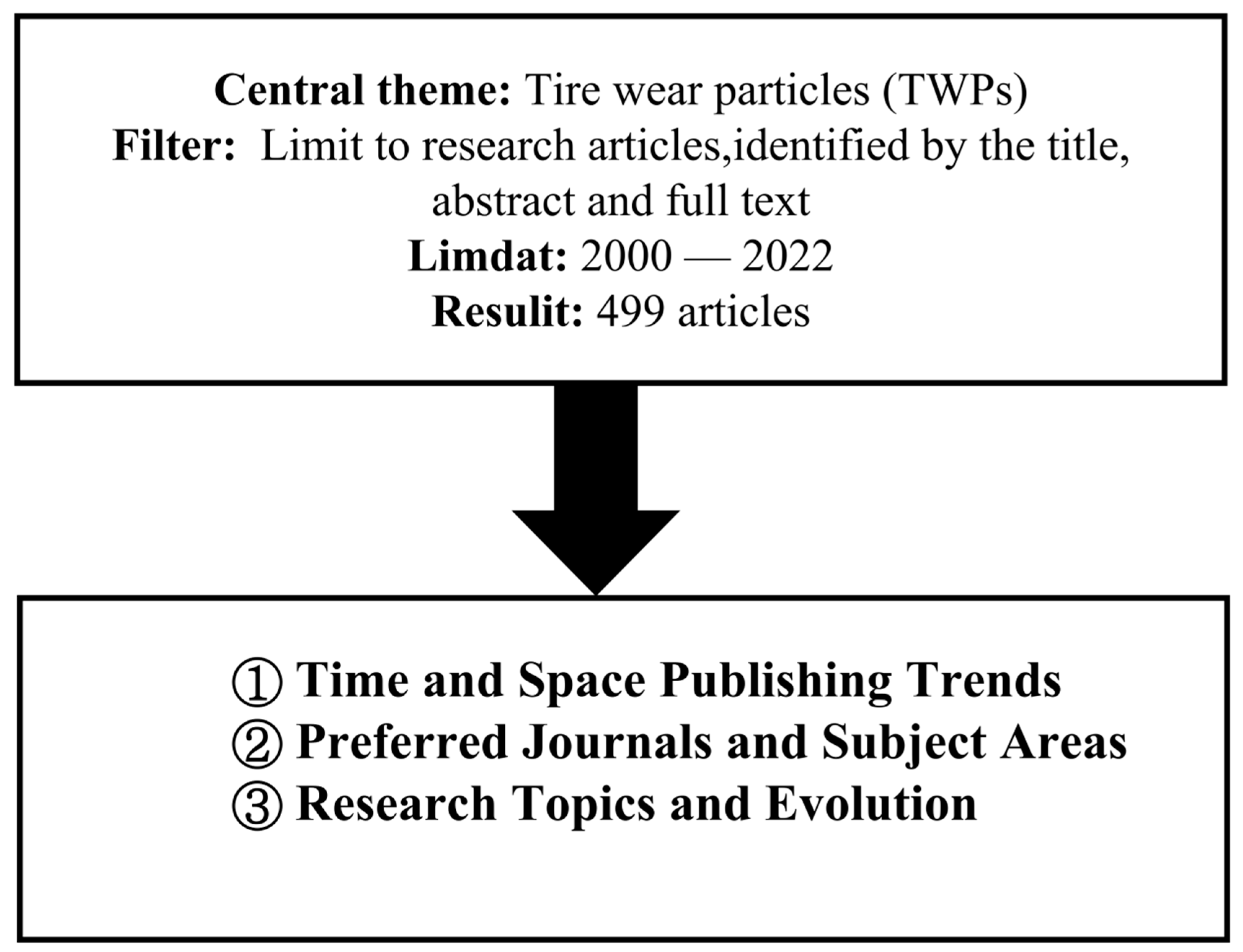
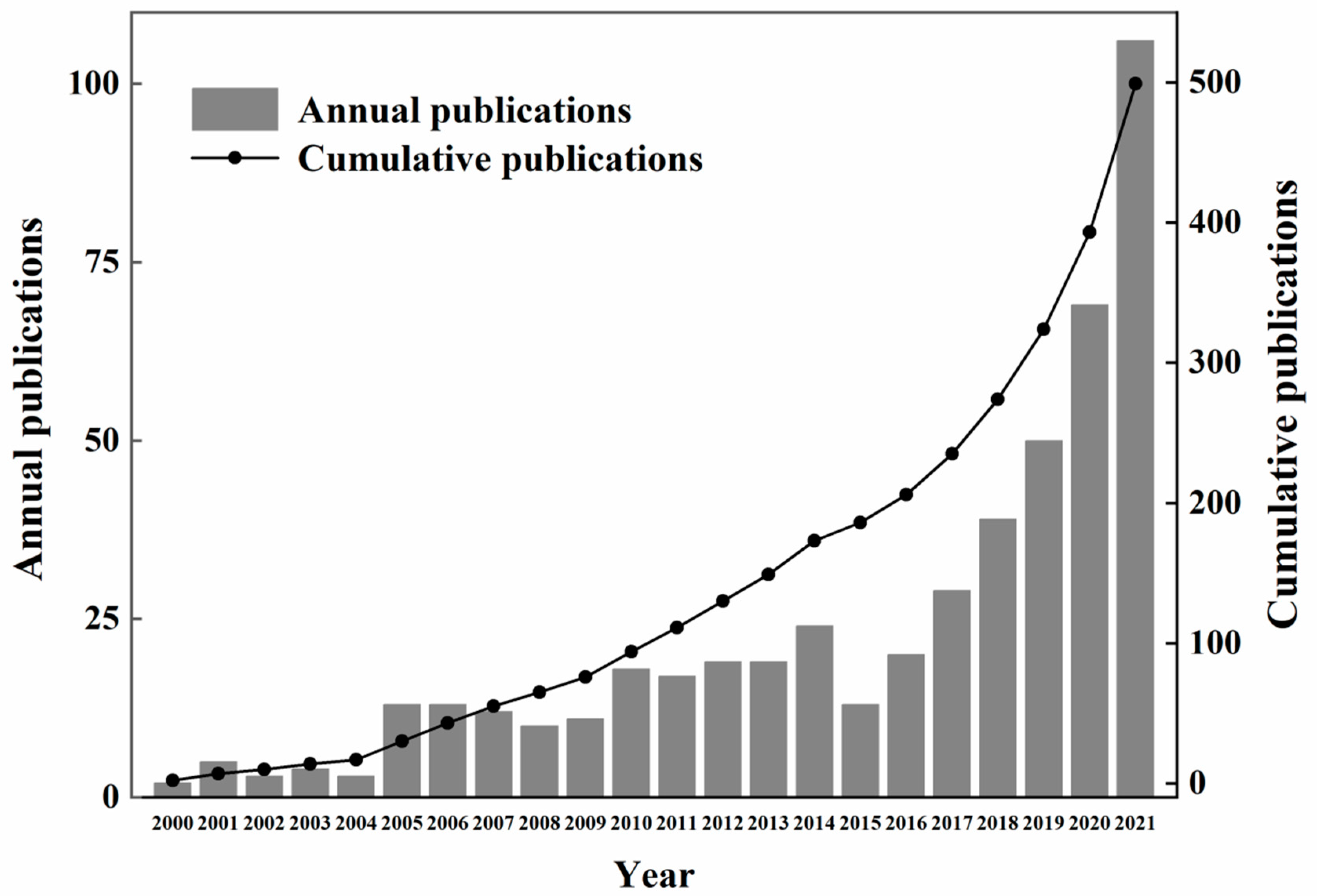
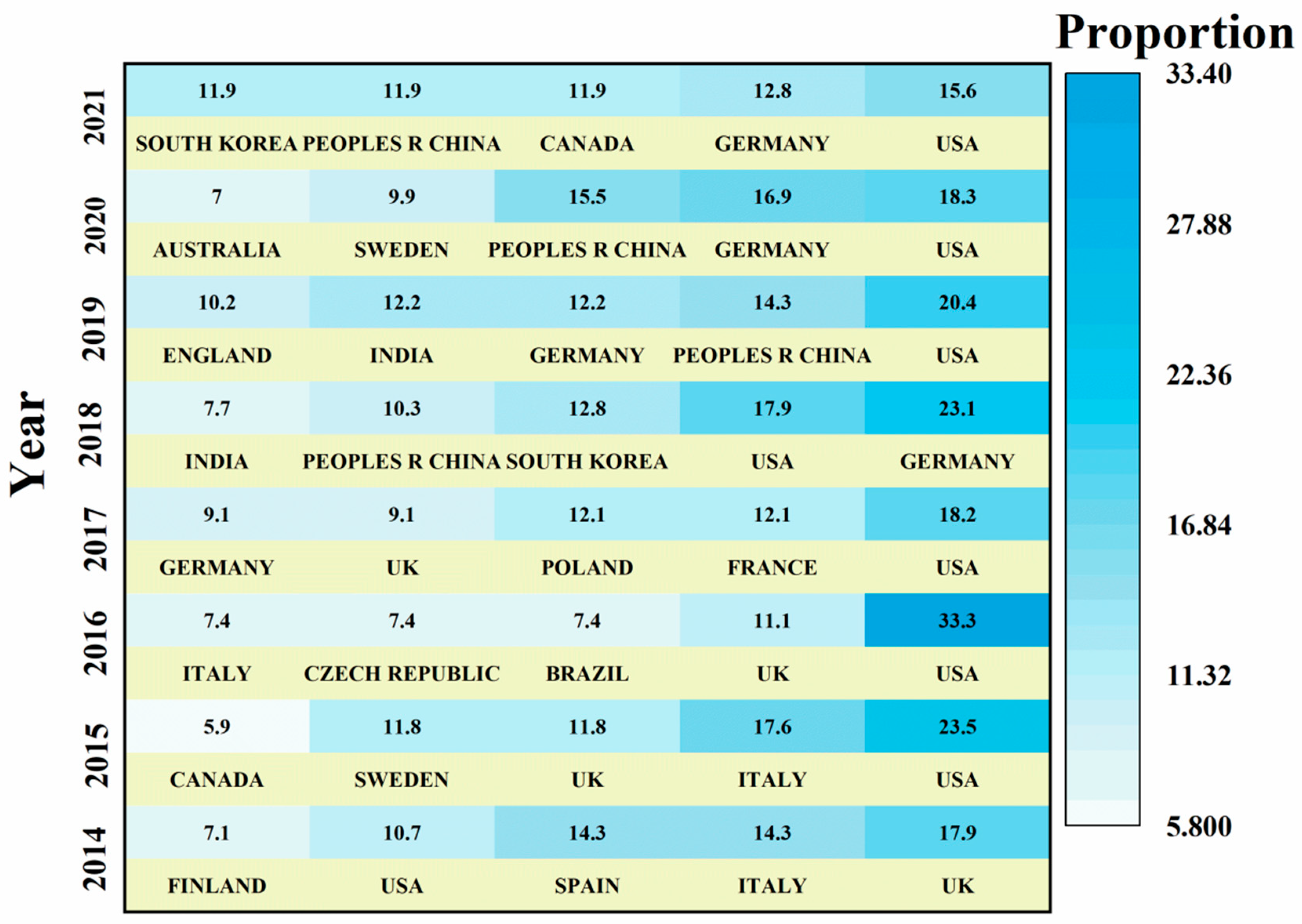
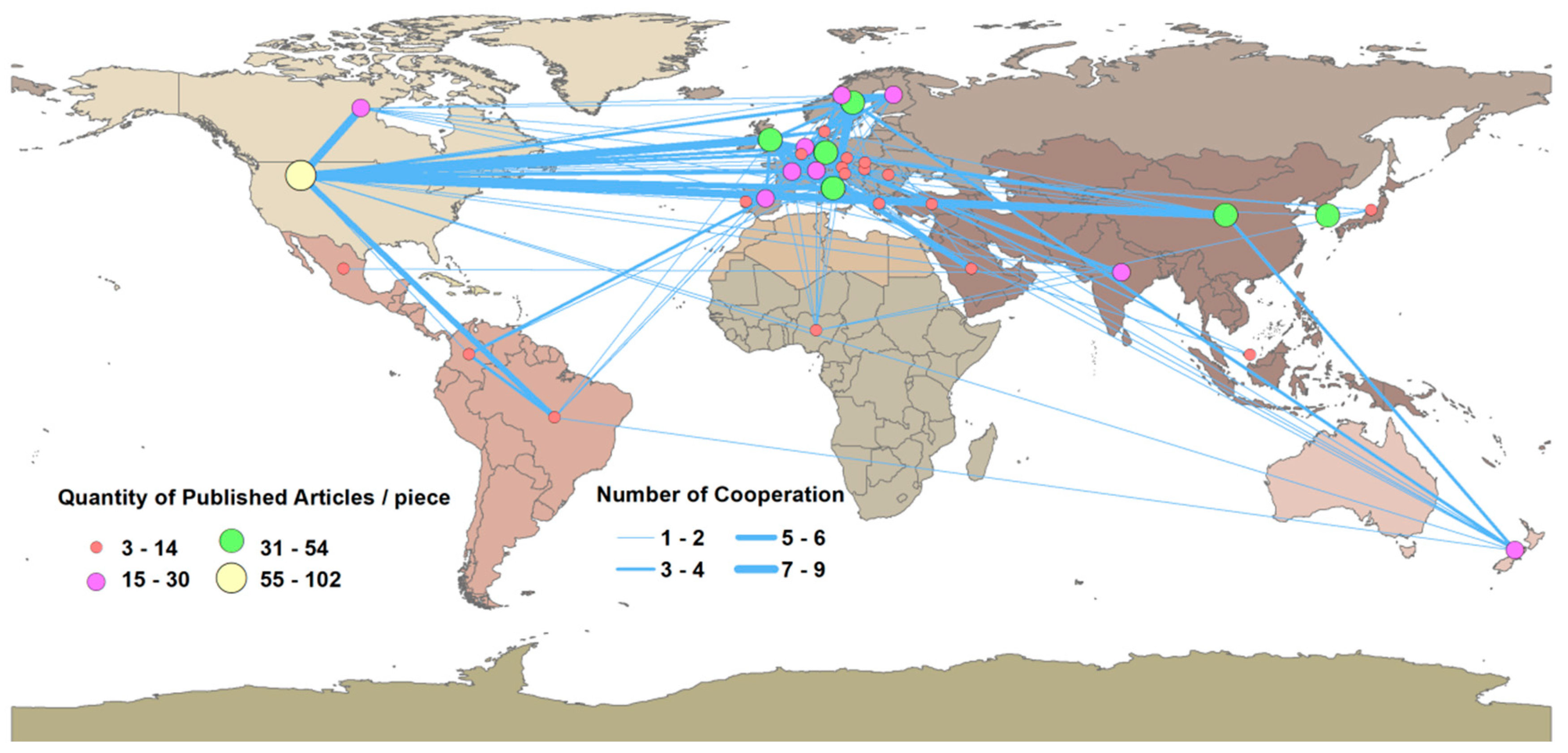



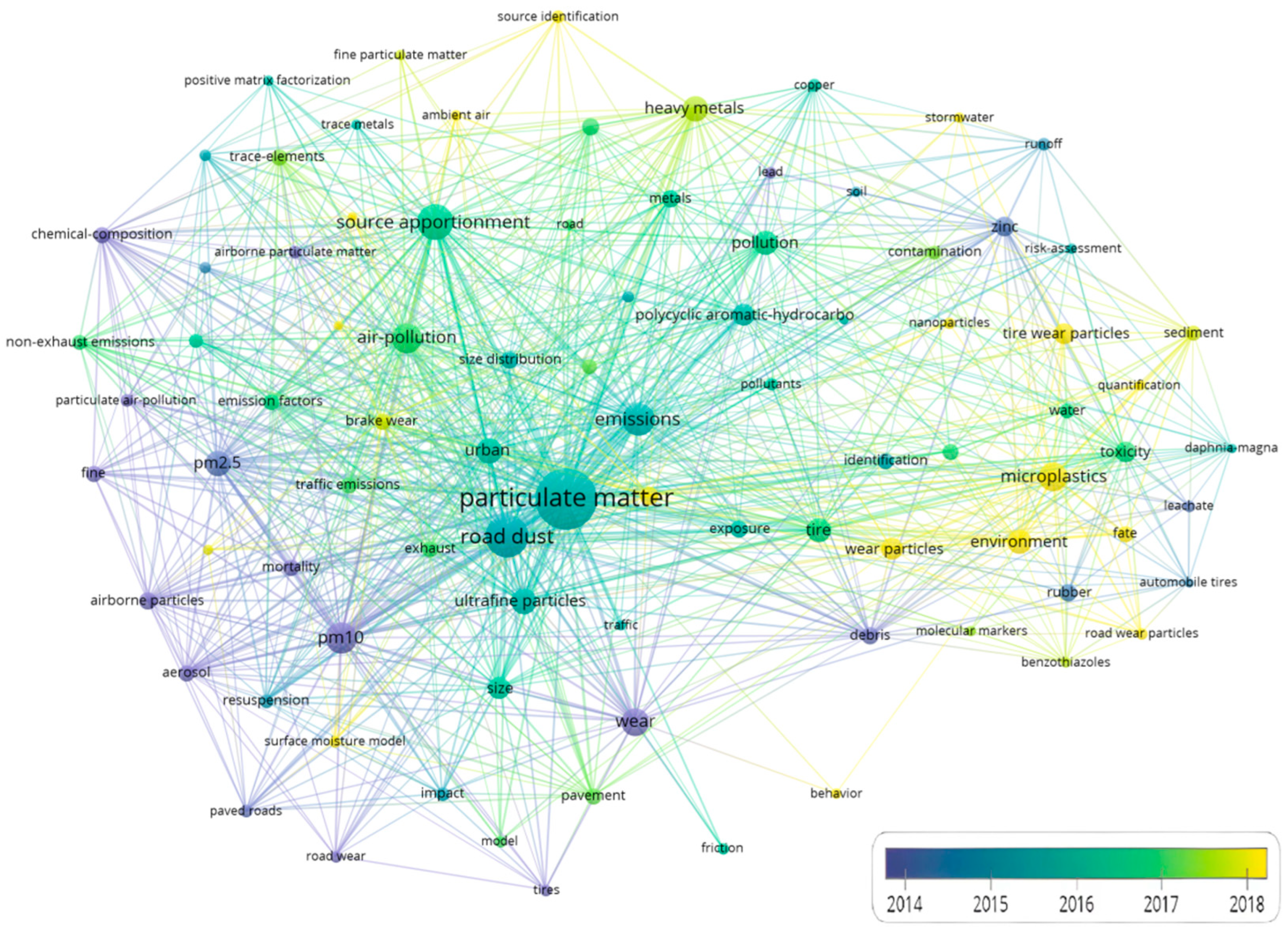
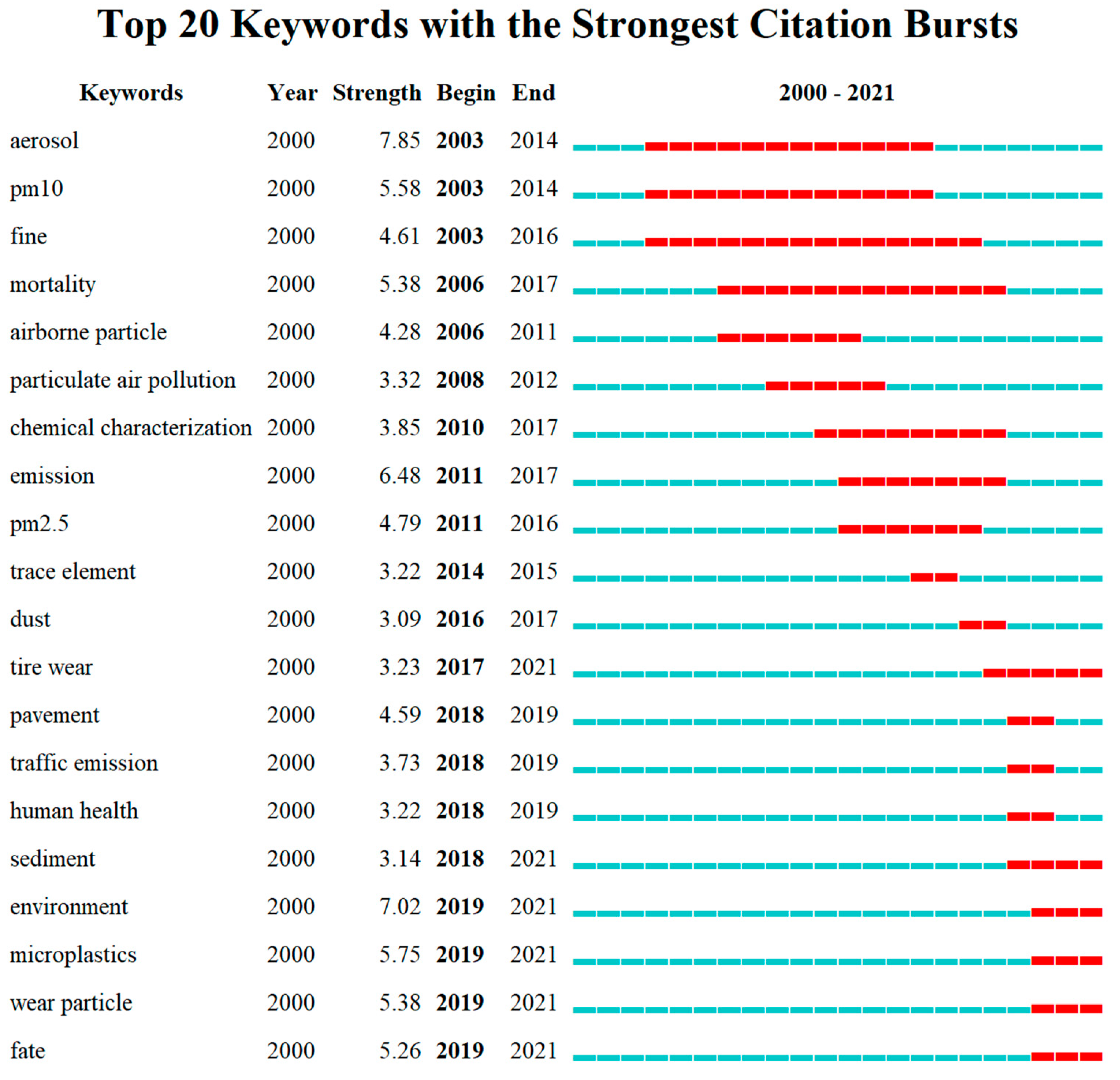
| Journal | Number | Percentage | IF | Citations | Year of Initial Publication | OA |
|---|---|---|---|---|---|---|
| Science of the Total Environment | 54 | 10.075 | 10.753 | 3468 | 2003 | 21 |
| Atmospheric Environment | 53 | 9.888 | 5.755 | 3972 | 2003 | 16 |
| Environmental Science Technology | 26 | 4.851 | 11.357 | 2683 | 2002 | 6 |
| Environmental Pollution | 23 | 4.291 | 9.988 | 788 | 2006 | 9 |
| Chemosphere | 12 | 2.239 | 8.943 | 631 | 2005 | 3 |
| Environmental Science and Pollution Research | 10 | 1.866 | 5.190 | 625 | 2013 | 6 |
| Water | 9 | 1.679 | 3.530 | 126 | 2013 | 0 |
| Environment International | 8 | 1.493 | 13.352 | 797 | 2004 | 5 |
| Journal of the Air & Waste Management Association | 8 | 1.493 | 2.636 | 299 | 2000 | 5 |
| Aerosol and Air Quality Research | 7 | 1.306 | 4.530 | 256 | 2014 | 7 |
| Keyword | Total Link Strength | Links | Occurrences |
|---|---|---|---|
| Particulate matter | 979 | 87 | 205 |
| Road dust | 669 | 83 | 111 |
| Source apportionment | 482 | 74 | 83 |
| Emissions | 403 | 82 | 70 |
| PM10 | 416 | 69 | 66 |
Disclaimer/Publisher’s Note: The statements, opinions and data contained in all publications are solely those of the individual author(s) and contributor(s) and not of MDPI and/or the editor(s). MDPI and/or the editor(s) disclaim responsibility for any injury to people or property resulting from any ideas, methods, instructions or products referred to in the content. |
© 2022 by the authors. Licensee MDPI, Basel, Switzerland. This article is an open access article distributed under the terms and conditions of the Creative Commons Attribution (CC BY) license (https://creativecommons.org/licenses/by/4.0/).
Share and Cite
Wu, W.; Ma, J.; Liu, D.; Xu, Q.; Li, G. Scientific Knowledge Mapping and Thematic Evolution for Tire Wear Particles. Sustainability 2023, 15, 583. https://doi.org/10.3390/su15010583
Wu W, Ma J, Liu D, Xu Q, Li G. Scientific Knowledge Mapping and Thematic Evolution for Tire Wear Particles. Sustainability. 2023; 15(1):583. https://doi.org/10.3390/su15010583
Chicago/Turabian StyleWu, Wei, Jun Ma, Dong Liu, Qiao Xu, and Gang Li. 2023. "Scientific Knowledge Mapping and Thematic Evolution for Tire Wear Particles" Sustainability 15, no. 1: 583. https://doi.org/10.3390/su15010583






